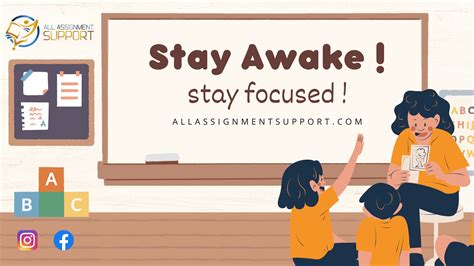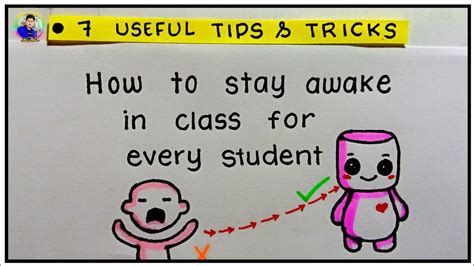How Do You Stay Awake In Class

Let's face it, staying awake and engaged during long lectures or monotonous classes can be a real challenge. Whether you're a student aiming to maximize your learning potential or an educator seeking to keep your students alert and attentive, this comprehensive guide will provide you with expert insights and practical strategies to conquer the battle against sleepiness in the classroom.
The Science Behind Sleepiness in Class

Understanding the causes of sleepiness is the first step towards finding effective solutions. Factors such as lack of sleep, boredom, uncomfortable seating, and poor classroom environment can all contribute to fatigue during class hours. Additionally, the human body’s natural circadian rhythm often peaks in the afternoon, making it a common time for sleepiness to strike.
Practical Strategies to Stay Awake

1. Get a Good Night’s Sleep
The most effective way to combat sleepiness is to ensure you get sufficient rest the night before. Establish a regular sleep schedule, aiming for 7-9 hours of quality sleep each night. Avoid late-night study sessions or binging on social media, as these can disrupt your sleep patterns and leave you groggy the next day.
2. Maintain a Healthy Lifestyle
A balanced diet and regular exercise can significantly improve your energy levels and focus. Opt for nutritious meals and snacks, and avoid heavy, sugary foods that can cause energy crashes. Stay hydrated by drinking plenty of water throughout the day, and engage in physical activity to boost your overall well-being.
3. Create an Engaging Learning Environment
As an educator, you have the power to make your classroom an exciting and stimulating place. Incorporate interactive activities, group discussions, and hands-on learning experiences to keep your students engaged. Use visual aids, varied teaching methods, and real-life examples to make the material more relatable and interesting.
4. Stay Active and Involved
Whether you’re a student or an educator, staying active during class can help keep you alert. Participate in discussions, ask questions, and take notes to actively engage your mind. Move around, stretch, or do some light exercises during breaks to increase blood flow and oxygen to your brain.
5. Utilize Effective Note-Taking Strategies
Taking notes is an excellent way to stay focused and absorb information. Use techniques like the Cornell Note-Taking System, which involves dividing your notes into three sections: cues, notes, and summary. This method helps you organize your thoughts, identify key concepts, and review your notes effectively.
6. Stay Mentally Sharp
Keep your mind active and sharp by engaging in mental exercises. Try solving puzzles, brain teasers, or even playing educational games during breaks. These activities stimulate your brain and improve your focus and concentration.
7. Use Strategic Breaks
Taking short breaks can help recharge your energy levels and prevent burnout. During breaks, step outside for some fresh air, do a quick stretch routine, or engage in a short meditation session to calm your mind and refocus.
8. Optimize Your Classroom Setup
As an educator, consider the layout and comfort of your classroom. Ensure proper lighting, adequate ventilation, and comfortable seating to create an inviting learning environment. Encourage students to bring their own cushions or back supports to make their seating more comfortable.
9. Incorporate Multimedia and Technology
Utilize multimedia tools and technology to enhance your teaching and keep students engaged. Presentations, videos, and interactive software can add variety to your lessons and capture students’ attention. However, be mindful of the potential distractions technology can bring, and use it strategically.
10. Practice Good Time Management
Effective time management is crucial for staying alert and avoiding fatigue. Plan your day and prioritize tasks to ensure you’re not overwhelmed. Break down larger tasks into smaller, manageable chunks to maintain focus and prevent burnout.
11. Foster a Positive and Supportive Environment
A positive and supportive classroom culture can significantly impact students’ motivation and engagement. Encourage collaboration, provide positive feedback, and create a safe space for students to express their ideas and ask questions. This approach can boost students’ confidence and enthusiasm for learning.
12. Embrace Variety and Adaptability
Recognize that different students have different learning styles and preferences. Adapt your teaching methods and materials to cater to a variety of learning needs. Incorporate diverse teaching strategies, such as visual aids, group work, and individual assignments, to ensure all students can actively participate and stay engaged.
13. Stay Informed and Adapt to Changes
Stay updated with the latest research and best practices in education. Attend workshops, conferences, and professional development opportunities to learn new teaching strategies and adapt to changing educational trends. By staying informed, you can continuously improve your teaching methods and keep your students engaged.
The Impact of Staying Awake in Class
By implementing these strategies, you can significantly improve your focus, engagement, and overall learning experience. Staying awake and alert in class allows you to actively participate, absorb information more effectively, and retain knowledge for longer periods. It also fosters a positive learning environment, enhances collaboration, and promotes a sense of community within the classroom.
| Strategy | Impact |
|---|---|
| Adequate Sleep | Improved focus, energy, and cognitive function |
| Healthy Lifestyle | Increased energy levels, better mood, and enhanced cognitive performance |
| Engaging Environment | Enhanced motivation, improved learning outcomes, and increased student satisfaction |
| Active Participation | Improved focus, deeper understanding of concepts, and better retention of information |
| Effective Note-Taking | Enhanced comprehension, improved organization of thoughts, and easier review of material |

How much sleep do I need to stay alert during class?
+The recommended amount of sleep for adults is 7-9 hours per night. Getting sufficient sleep is crucial for maintaining alertness and cognitive function during the day.
What are some effective note-taking techniques?
+The Cornell Note-Taking System is a popular and effective technique. It involves dividing your notes into cues, notes, and summary sections, allowing for better organization and review.
How can I create an engaging learning environment as an educator?
+Incorporate interactive activities, varied teaching methods, and real-life examples. Use visual aids and encourage student participation to create a stimulating learning environment.



